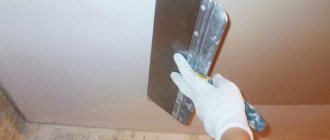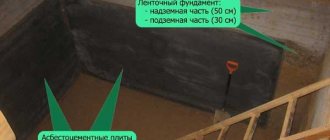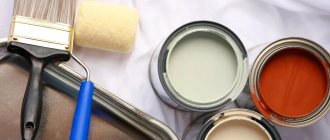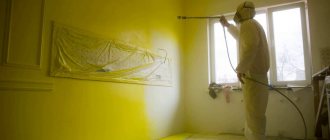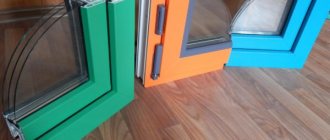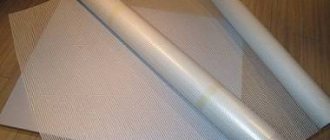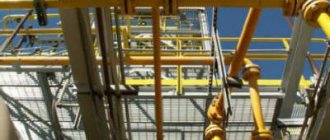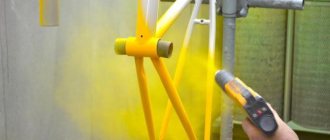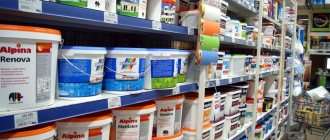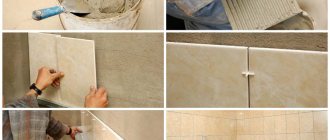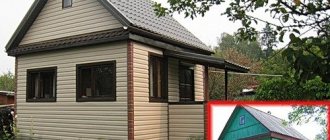Electrostatic painting - features of the process
Electrostatic painting is a technology when paint is applied to a surface using interaction forces between point stationary electric charges (Coulomb force). The paint and varnish material (most often they are water-based, but there are also options with an organic solvent) is applied using a special paint gun.
The electrostatic type sprayer was first used in 1941 by such an American inventor as G. Ransburg. The method will involve the use of electric fields through which charged particles of paint and varnish material move. Liquid paint begins to interact with the electrode, which is located in the gun, and as a result, a high-voltage negative charge (from 60 to 100 kW) will be transferred to the paint.
Charged particles coming out of the spray gun nozzle will be directed along field lines (electrostatic) to the product, which is grounded and on which paint and varnish material is applied.
What is needed to bring an idea to life?
Room
An ordinary room in the form of a garage box is sufficient; in the summer, the car can be painted outdoors, having previously covered it with polyethylene walls on the windy side.
Equipment
Does not require professional equipment; an electric spray gun with the HVLP (HighVolumeLowPressure) marking, type WAGNER W560, approximately costing $100, is sufficient.
Material
The paint is a composite rubber-like composition applied in liquid form, which turns into a durable protective film within 4 hours after applying the last layer.
As you can see, the necessary material and raw material base is available even to beginning businessmen.
The most important cost item is directly related to the purchase of the Dempinox composite. There is no need to worry about this, as these costs are reimbursed after the order is completed.
8.3. Electrostatic Spray
In terms of importance and distribution in industry, electrostatic spraying occupies one of the leading places. This method is economical, provides good quality coatings, the ability to automate the process and high productivity. By applying an electric field to aerodynamic particles, almost complete deposition of the sprayed paint and varnish material onto products is achieved (losses not >10%).
In an electric field, it is possible to paint products of complexity groups I and II, made from various materials, using stationary and manual installations. This method is especially suitable for painting small products of not very complex shapes: instrument parts, auto, bicycle and motorcycle parts, electrical products, fittings, household appliances, furniture, shoes, etc. It is also used when painting medium- and large-sized products, such such as car bodies and cabins, railway and tram cars, buses. Good results were obtained both in mass production and when painting individual products. When using stationary installations, sanitary and hygienic working conditions are significantly improved, and the overall production culture improves.
Disadvantages: complexity and increased cost of painting equipment, some restrictions in the use of paints and varnishes.
Basics of the method. The essence of the electrostatic method is to spray a paint and varnish material while simultaneously imparting an electric charge to the resulting aerosol particles, due to which they are uniformly deposited on an oppositely charged product.
For electrostatic application, any method of generating aerosols is acceptable, but the most common are mechanical (centrifugal), pneumatic and hydraulic (airless) spraying. The appearance of a charge on particles is associated with the application of a constant high voltage electric field (50-140 kV), and the product is usually grounded.
There are several ways to charge aerosol particles, which determine different approaches to the hardware design of the processes. Two of them have found practical use: ionic and contact.
Ionic charging. Ionic charging (charging by ion adsorption) is widely used in many electron-ion technology devices due to its high efficiency and simplicity of the process. The source of ions is usually a corona discharge that occurs in the space between two electrodes, for example, between an electrode grid connected to a high voltage source and a grounded workpiece. One of the important properties of a corona discharge is its ability to impart a charge to an aerosol located at some distance from the electrode.
The charge arises as a result of the adsorption of ions resulting from the ionization of air by aerosol particles. Adsorption occurs until the repulsive forces between the ions deposited on the particle and the attractive forces of the ions by the particle are equalized. Adsorption of ions causes the directed movement of aerosol particles (droplets) along the field lines towards the product being painted (Fig. 8.4).
Rice. 8.4. Particle ion charging scheme:
1 – corona electrode; 2 – gas molecules; 3 – paint particle; 4 – product
The maximum charge qmax acquired by a drop of paint and varnish material can be calculated using the Potenier equation:
where e is the dielectric constant of the paint and varnish material; E – field strength at a given point; r is the radius of the drop.
In this case, the field strength for a point charge Q is equal to:
(8.6)
where is the dielectric constant of the medium (air); l is the distance from the charge to the grounded object.
Contact charging. Contact charging (or charging by electrostatic induction) occurs as a result of contact of the paint and varnish material with the sharp edge of the spray gun, which simultaneously plays the role of the discharge electrode. For better charging of the material, an elongated electrode is usually chosen, forming a tip-shaped edge. The smaller the radius of the sprayer, the greater the electric field strength in this place and the easier it is for a corona charge to arise, causing sputtering and charging of the material. A corona discharge is formed at the tip of the electrode edge if the field strength reaches 3 MV/m. In this case, electrical charges intensively flow into the air, causing its ionization in the space adjacent to the electrode.
When a high voltage is connected to the discharge electrode, a high-density surface charge is created at the tip of its edge. If a thin layer of paint and varnish material is applied to such an edge, it will be charged and, under the influence of the forces of the electric field, will be stretched and flow from the surface in the direction of the grounded product (Fig. 8.5).
Rice. 8.5. Scheme of electrostatic spraying and contact charging of particles:
1 – corona electrode; 2 – layer of paint and varnish material; 3 – product
A directed moving aerosol of charged particles (droplets) of paint and varnish material is formed.
The charge of an aerosol drop obtained during contact charging is determined from the equation:
(8.7)
where U is the voltage supplied to the electrode; Uк is the current voltage that is equal to the appearance of the corona discharge current; — radius of curvature of the nozzle edge; l is the distance from the sprayer to the product; A – calculated constant; — dielectric constant of the paint and varnish material; — specific volumetric electrical resistance of the paint and varnish material.
As follows from formula (8.7), the charge increases with increasing applied voltage and decreases with increasing l, , , . The charge also increases in proportion to the square of the radius of the drop. However, the mass of the drop, which determines the kinetic stability of the aerosol, increases even faster - proportional to the cube of the radius.
Therefore, a high degree of dispersion of the paint material has a beneficial effect on spraying.
During contact charging of paint and varnish material, the charge of aerosol particles is 10–30 times greater than with ionic charging, therefore industrial electropainting installations operate primarily using the contact charging method.
Charging droplets contributes not only to their fragmentation and directional movement, but also to the formation of particles. Unlike pneumatic spraying, with electrostatic spraying, a torch is formed as a result of the mutual repulsion of similarly charged droplets. The angle between the generatrices of the torch is a function of the field strength E, radius r and charge Q of the drop:
A large torch angle is not always desirable, because losses of paint and varnish material increase due to entrainment by ventilation. Therefore, in practice, various methods of focusing materials are used, taking into account the size and shape of the products being coated.
Charged particles formed when sprayed in an electric field move towards the surface of the product being painted along a certain trajectory. It is formed under the influence of forces acting on the particle:
(8.8)
where Fq is gravity; Fk is the force due to the action of the electric field, Fk = Eq max; FE is the force due to the uneven distribution of the electric field strength; Fc is the force of interaction of a particle with other nearby particles.
The counteracting force is the force caused by the resistance of the air to the movement of the particle. The speed of movement decreases in proportion to the logarithm of the particle radius. Thus, at a maximum field strength of 0.5 MV/m, the speed of movement of a particle with a radius of 100 μm does not exceed 1 m/s. Large particles with a large mass, which have received a small charge, can deviate so much when moving that they fall out of the influence of the electric field and are carried away by ventilation without reaching the surface of the product.
The discharge of particles completes the cycle of processes associated with the transfer of matter into the field of a corona discharge, and is at the same time a process of astabilization of the dispersion. Along with the transition of droplets to a neutral state (as a result of charges flowing onto a grounded product), their merging occurs; the viscosity of the resulting liquid film continuously increases due to the evaporation of the solvent, and the electrical parameters of the layer change accordingly.
When drops come into direct contact with the surface, the rate of their discharge is determined by the material’s own conductivity: the more (or the less), the faster and more completely the charges drain. Thus, the specific volume resistance at different stages of applying paints and varnishes plays a dual role: with its increase, the charging of aerosol particles becomes easier and at the same time their discharge becomes more difficult.
If paint is deposited on an already deposited layer of paint and varnish material or on a previously painted (primed) surface, then the resistance of this layer has a decisive influence on the discharge. With high resistance, charges accumulate on the surface, and the deposition of paint and varnish material is reduced or completely stopped.
Therefore, in practice, depending on the electrical resistance of the film, 1–3 layers of paint and varnish materials are applied. Often double layers are applied: the next layer is applied on the previous one, which has a relatively low value.
Application of paints and varnishes in automated installations. The positive qualities of electrostatic spraying are most fully manifested when using stationary installations operating in automatic mode.
Rice. 8.6. Schematic diagram of a stationary electropainting installation:
1 — painting chamber; 2 – remote control; 3 – conveyor; 4 – product; 5 — electrostatic sprayer; 6 - dosing device; 7 — kenotron current rectifier; 8 - electrostatic generator; 9 – exhaust ventilation
The designs of such installations are very diverse, but they all contain the following main components: an electrostatic sprayer, a dosing device, a high-voltage DC source, including an electrostatic generator and a kenotron rectifier, a spark-preventing (or safety) device, a spray booth (Fig. 8.6).
Electrostatic sprayer is one of the important elements of installations. Depending on the method of spraying paints and varnishes, electrostatic sprayers are used: with a fixed corona edge (cup ER-7, ER-8, ERV-1, fungal disk), pneumoelectrostatic (brands KEP-2, AREG-1), electro-ultrasonic (type UUE -1), hydroelectrostatic (type KRGE–1).
Electromechanical sprayers. Electromechanical sprayers, primarily cup sprayers, are most widely used when painting products in an electric field (Fig. 8.7). They are compact, simple in design and reliable in operation. The working body of such sprayers is a corona nozzle in the form of a bowl with a diameter of 50–150 mm.
Rice. 8.7. Electrostatic sprayer (cup) ER-8:
1 – spray body; 2 – bowl; 3 – stand; 4 – bracket
The rotation of the corona nozzle is carried out using an electric drive, usually at a frequency of 1200–1400 rpm. Recently, high-speed cup and disk atomizers have been developed with a rotation speed of 30–60 thousand rpm. In particular, these include the ERV-1 sprayer. The paint material entering the electromechanical sprayer usually acquires a charge in the charger, which is supplied with high voltage (80-120 kV); Then it enters the bowl, on the edge of which it is dispersed. The productivity of electromechanical sprayers is 1.5-2.5 g/min per 1 cm of corona edge length. For ER-8 sprayers, depending on the diameter of the bowl (bowls with a diameter of 60-10 cm are used), this is 1.8-4.5 kg/h for paint, or 60-150 m2/h for the surface to be painted.
For large volumes of painting work, the installations are equipped with several sprayers (from 2 to 6), which are paired with mechanisms that ensure their swinging or reciprocating movement in a vertical plane (devices such as “Rocking Chair”, “Robot”, etc.). The distance from the corona edge to the product is usually 200-300 mm.
Pneumoelectrostatic sprayers. Pneumoelectrostatic sprayers create a more directional movement of the aerosol of paint and varnish material than electromechanical ones and thus allow better painting of recesses in products.
Spraying of paints in them is carried out using a jet of compressed air supplied under a pressure of 0.05-0.4 MPa. The painting performance of different types of sprayers ranges from 30 to 300 g/min.
Slot electrostatic sprayers. Slotted electrostatic sprayers ShchER-1 and ShchER-2 are very productive. The length of their corona edge is 500 and 700 mm, respectively, and the paint productivity reaches up to – 120 g/min. They have proven themselves especially well when painting large-sized products and objects with a simple surface profile: railway and tram cars, diesel locomotives, subway cars, etc.
Sources of high voltage direct current in automated installations are usually the high-voltage rectifier unit UV-160-2.5, cascade or rotary generators. (The AREG-1 atomizer has an electrogas-dynamic generator built into the body, which increases the voltage from 6 to 45 kV).
The supply of electrostatic and electrodynamic sprayers with liquid paints and varnishes is provided using the DKKH-3 dosing device.
Using electrostatic spraying, you can apply various types of paint and varnish materials: primers, varnishes and enamels: alkyd, urea-formaldehyde, melamine-alkyd, oil-styrene, epoxy (single-pack), etc. Paints and varnishes with , Ohm×m, and a viscosity of 25-70 mPa are well applied. ×s (by rheostat), or 14-25 s according to B3-4. To dilute these materials, RE grade thinners are used. The thickness of single-layer coatings when applied is 18-25 microns. When using sprayers with a high bowl rotation frequency, it is possible to use paints and varnishes with a viscosity of 60-80 s according to B3-4, while the thickness of the resulting single-layer coatings increases by 25-30% (Fig. 8.8).
h, s d, µm
n×10-4, rpm
Rice. 8.8. Dependence of the limiting values of viscosity h of ML-12 enamel during application and the thickness of the coating layer on the rotation speed of the electrostatic spray bowl
The application of paints and varnishes containing highly volatile solvents (cellulose nitrate, vinyl, acrylic) is used to a limited extent due to the sharp increase in viscosity at the edge of the spray nozzle and the increased fire and explosion hazard. Their application is permitted only on installations equipped with spark-preventing devices. The application of water-borne paints and paints containing metallic pigments also presents certain difficulties: due to high electrical conductivity, charges leak through the paint layer. This prevents it from charging and makes it unsafe to work on the installations. For automatic pneumoelectrostatic application of water-soluble paints and varnishes with Ohm×m, the RVLM-1 sprayer has been developed.
Electrostatic spraying is usually used to paint metal products. It is also possible to apply paints to non-metallic materials that have a surface electrical conductivity of at least 10-8 cm. Thus, paints and varnishes are well applied to wood with a moisture content of 10-12%, for which cm. When painting wood with lower humidity, special measures are used to increase its electrical conductivity: surface moistening, treatment with surfactant solutions (for example, 5-10% solution of alkamon DS-M or KM in white spirit) or acids (in particular, phosphoric), application of special conductive primers.
When painting plastic and rubber products, metal screens or inserts are installed on the inside of the product, current is supplied from an external source (a method of neutralizing potentials), and the outer surface is treated with surfactant solutions. For example, the deposition of varnishes on rubber boots proceeds satisfactorily if they are hung on grounded metal blocks on a conveyor; paint and varnish materials are deposited more completely on wooden cases of radios and televisions with internal metal inserts.
The uniformity and quality of coatings obtained in an electric field is greatly influenced by the shape of the products being painted and their assembly on hangers. On products of complex configuration, an uneven electric field is created: charges are concentrated on the edges and protruding parts of the surface, on the contrary, in recesses, grooves, they are absent or their density is lower. Therefore, the paint and varnish material is deposited primarily on convex and smooth surfaces; internal corners, vessel cavities, and various grooves and narrow cracks, as a rule, are not painted over in an electric field. On a conveyor belt, shielding of some products by others causes uneven distribution of the paint and varnish material on the surface. To improve uniformity, additional non-corona electrodes are often installed or electrostatic spraying is combined with other methods of applying paints and varnishes.
Stationary electropainting installations are equipped with ventilation. The speed of air movement inside the chamber is low. Usually does not exceed 0.2-0.3 m/s, in open openings 0.4-0.5 m/s. Unlike pneumatic spray booths, electrospray booths do not have hydraulic filters. To ensure safe servicing, the units are equipped with automatic blocking and signaling devices.
Application of paints and varnishes using manual installations. Manual electropainting installations are used when the volume of painting work is small and the use of stationary installations becomes unprofitable. They are convenient for painting single and large-sized products in non-conveyor production conditions, as well as for repair work. The use of manual installations is especially effective when painting meshes, gratings, long and some other products.
Their advantages: portability, maneuverability, combined with more economical (compared to pneumatic spraying) consumption of materials.
Electro-painting installations with mechanical (centrifugal), pneumatic and hydraulic spraying of paints and varnishes have become widespread: UERTs-1, UERTs-4, URETs-4, UREG-4, UREG-2, Oreol-100. All installations are mobile. UREG-2 – portable.
Their main components:
1) electric spray gun with high voltage cable and spray hose;
2) high voltage generator;
3) paint dispensing device.
The UERTs-4 installation has two replaceable nozzles, one of which is electromechanical, the other is pneumoelectrostatic. An electromechanical sprayer with a rotating corona nozzle ensures complete paint deposition of 94-96%. It is convenient to use when painting products and objects with smooth surfaces: railway cars, control panels and panels, machine tools, welding machine bodies, pipes, etc. The completeness of paint deposition when using pneumoelectrostatic spraying is less (70-80%), but it provides better painting products of complex shape: parts of metal-cutting machines, bearing stands, turbine parts, etc. Hydroelectrostatic installations of the UGER type are distinguished by higher productivity (300-600 g/min for paint), the most advanced of which is the UGER-4 installation, equipped with a KEV-3 sprayer ; the paint is sprayed into it under a pressure of 6-8 MPa.
The UREG-2 electropainting installation, used for applying paints and varnishes to small and medium-sized products of varying complexity (pipes, gratings, meshes, etc.), is equipped with a pneumo-electrostatic sprayer with a built-in electrogas-dynamic generator. Spraying of paint and varnish material is carried out under air pressure of 0.45-0.60 MPa and a voltage of no more than 45 kV; paint productivity 250-500 g/min. Urea-formaldehyde, glypthal and pentaphthalic paints and varnishes are usually applied using manual electro-painting systems. Their optimal viscosity when applied with electromechanical sprayers is 15-20 s, pneumo-electrostatic 20-25 s according to VZ-4. Application of cellulose nitrate, perchlorovinyl, water-borne paints and varnishes, as well as paints containing aluminum powder (hammer paints, etc.) by manual electrostatic spraying is not allowed for the safety of operating personnel.
Painting with manual electrosprays is usually carried out in special chambers equipped with an exhaust ventilation system. The internal dimensions of the chambers are selected so that the products can be freely rotated in the chamber in any position up to the walls and floor of the chamber at least 0.8 m. Otherwise, paint may be deposited on the walls of the chamber. The volume of air removed from the painting booths is determined by the speed of its movement in open openings, which when using electromechanical sprayers is taken to be 0.3-0.4 m/s, pneumo-electrostatic 0.4-0.5 m/s.
If the necessary rules of use are observed, manual electropainting systems are not dangerous to operate. The design of the installations eliminates sparking. The short circuit current is small and does not pose a danger to humans. In particular, in the UREG-2 installation it does not exceed 40 μA, while in automatic stationary installations it reaches 0.1 A. Careful grounding of the equipment is provided.
Spray Types
Two types of electrostatic spraying are used - classic and cascade. The classics assume that a high-voltage direct current is supplied to the electrostatic spray gun through a high-voltage cable. The classical scheme has a number of significant disadvantages. First of all, we are talking about voltage instability in the pistol electrode. In addition, painting is quite inconvenient, since the large cable makes it difficult to operate, and to turn off the power supply you need to get to the transformer every time.
In the cascade technique, high voltage is not generated externally, but in the gun itself. A voltage of only 12 V is sent to the gun via a low-voltage cable, and high voltage is generated inside the device. The transformation is carried out at the spray gun cascade. The cable used is thin and flexible, making it very convenient to work with.
The cascade method allows you to turn off the supply of electricity regardless of the generator, as well as control the voltage level, choosing the appropriate one for a particular type of material. The voltage itself is highly stable, which makes it possible to significantly reduce paint consumption. The main disadvantage of cascade spraying is the high cost of the equipment. However, the costs are quickly recouped due to the cost-effectiveness of this technology.
Electrostatic spraying has some limitations dictated by the following circumstances:
- Properties of paint and varnish material. In order for the paint to charge correctly on the electrode, a resistance of at least 30 kOhm is required. Otherwise, the efficiency of painting in an electrostatic field is radically reduced. As an example of a paint and varnish material with a low level of resistance, we can cite compositions with significant additions of metal powder (these include metallic enamels). Until recently, electrostatic painting was not used when applying water-soluble paints, since there was a high risk of short circuits due to the electrical conductivity of the liquid. The latest models of equipment for electrostatic painting allow you to work with water-soluble coatings.
- Properties of the material. Non-conductive items such as plastic and wood are difficult to paint. The process can be facilitated by using special conductive primers (in the case of plastic) or moisture (for wood).
- The shape of the part to be painted. As mentioned above, the electrostatic method allows you to paint products of various shapes, however, in a closed conductive circuit, the voltage of the electrostatic field is zero. Therefore, in deep recesses there is no electric field, which is why particles of paint and varnish material do not fall into such areas. Moreover, without getting into all kinds of depressions, the paint concentrates on other areas (for example, on the edges), which leads to the formation of a too thick layer of coating. To avoid such problems (they are called a Faraday loop), painting hard-to-reach areas is carried out with a conventional spray gun - airless or pneumatic.
Details
Spray types
Two types of electrostatic spraying are used - cascade and classic. By the way, the latter assumes that high-voltage direct current is supplied to the electrostatic spray gun through high-voltage cables. The classic scheme has many significant disadvantages. First of all, we will talk about voltage instability in the pistol electrode. Moreover, painting is very difficult, because a large cable will hinder the operation, and in order to turn off the power supply you need to get to the transformer every time.
In the cascade method, high voltage is generated not from the outside, but in the gun itself. A voltage of only 12 V is sent to it via a low-voltage cable, and a high degree of voltage will be generated inside the device. The transformation is carried out on a spray cascade. The cable used is flexible and thin, making it extremely convenient to work with.
The cascade method makes it possible to turn off the supply of electricity regardless of the generator, and also control the voltage level, and select the appropriate one for a particular type of material. The voltage itself will have a high degree of stability, which makes it possible to significantly reduce the consumption of paint and varnish material. The main disadvantage of cascade spraying will be the high price of equipment. But the costs can quickly be recouped due to the cost-effectiveness of such technology.
Electrostatic spraying has certain limitations, which are dictated by the following circumstances:
Properties of paint and varnish material. We are talking about liquid electrostatic painting. In order for the paint to charge correctly on the electrode, a resistance of at least 30 kOhm is required. Otherwise, the efficiency of dyeing in an electrostatic field will be radically reduced. As an example of a paint and varnish material with a low level of resistance, we can cite compositions with large additions of metal powder (these include metallic enamels). Until recent years, electrostatic painting was not used when applying water-based paints because there was a high risk of short circuits due to the electrical conductivity of the liquids. The latest models of electrostatic painting equipment make it possible to work with water-soluble paints and varnishes.- Properties of materials. Products that do not conduct current, such as wood and plastic, are quite difficult to paint. The process can be facilitated only with special conductive primers (in the case of plastic) or moisture (for wood).
- The shape of the processed parts. As mentioned earlier, the electrostatic method makes it possible to paint products of different shapes, but in a closed conductive circuit the electrostatic field voltage will be zero. For this reason, there is no electric floor in deep recesses, which is why particles of paint and varnish material will not fall into such areas. Moreover, without getting into various depressions, the paint will concentrate on other areas (for example, on the edges), and this will lead to the formation of a very thick layer of coating. To avoid such problems (often called a Faraday loop), painting hard-to-reach places is carried out using a simple spray gun - airless or even pneumatic.
Consider a dyeing device. Spray gun "Star 3001"
As an example, we should disassemble the Star 3001 paint sprayer. This device uses a cascade method for generating high voltage. They use both mechanical and even automatic methods to improve equipment. Both models are capable of working with both airless spray and air-type mixture. There are still separate modifications for water-soluble paints and solvent-based paints. Each model, depending on its purpose, can differ greatly in the materials used in it, and also have its own design features.
It turns out that the range of equipment is incredibly wide, and therefore before purchasing you need to decide how exactly the electrostatic gun will be used. Device 3001 is required for working with water-based paints and varnishes. This will indicate that the device is protected from short circuits, because the design is made of a special material. But for working with organic solvents, Star 3001 is not suitable, and therefore it is necessary to find a modification whose body is inert to various solvents.
Problems with the Faraday circuit in a sprayer of this model can be solved by turning off the electrical power. If there is no power, the paint material is sprayed only under pressure. The voltage control keys are located directly on the body of the spray gun, and this is very convenient. Moreover, you can even control the pressure yourself - just pull the trigger. The gun is also equipped with memory, due to which up to 3 variants of the electrostatic field are supported for each type of paint and varnish material. An important parameter of any paint and varnish material used will be electrical resistance. A probe is supplied with the device, which tests the paint material for resistance, and thus provides the best indicator for the electrostatic field.
Despite the technical equipment, this electrostatic painting gun is easy to maintain. The housing can be easily disassembled, and after that all mechanisms are accessible to visual observation. If it breaks, you can replace any elements of the gun. This circumstance makes it possible to simplify repair work and also reduce its cost. It should be noted that the device also weighs only 0.9 kg, and due to its lightness, it will be physically easy to work with it, and due to the ergonomic handle it will be comfortable. For industrial use, a modification such as “LARIUS 2 Paint Systems” has been developed. This system uses a double diaphragm, due to which the paint material is injected under low pressure.
Design and types of electrostatic paint sprayers
If we compare electrostatic paint sprayers with traditional ones, then the common features can be considered the principle of operation of the material and air-conducting channels, and the main differences are the presence of an electrode that charges paintwork materials, and a high-voltage system that ensures the presence of electrical potential on this electrode. In addition to the fundamental differences in paint gun design described above, it should also be noted that the body of traditional paint guns is typically made of steel or aluminum, while in the case of electrostatic paint guns, the body is usually made of a combination of insulating and conductive plastics in order to maximize Protect the painter from electric shock.
There are two types of high-voltage systems for electrostatic paint sprayers: classic and cascade. Let's take a closer look at them.
In the case of classic (external) high voltage systems, high DC voltage is supplied directly to the spray gun from a transformer (high voltage source) using a high voltage cable. The advantages of paint sprayers that use classic high-voltage technology include simplicity of design and the absence of electronic elements in the spray gun body; relatively light weight of the spray gun; built-in short circuit protection; lower cost of the spray gun and good maintainability, but the disadvantages are instability of high voltage on the electrode; lack of an independent power switch on the spray gun.
Spray types
Two types of spraying are used - standard and cascade.
Standard means that a direct current flows through the cable to the spray gun, and the voltage is very high. This option has a large number of disadvantages. The first is voltage drops in the gun electrode.
Also, the painting process is not very convenient due to the large cable, which interferes with free movements, and to turn off the device, you always have to go to the transformer. With the cascade method, high voltage is created in the gun.
A low voltage cable (about 12 V) is connected to the device itself, and a high voltage is created in the spray gun itself.
Generation occurs on the pistol cascade. The cable that is used is very flexible and thin, which is why the process is quick and easy.
When using the cascade method, electricity is turned off without the participation of a generator, as well as voltage control depending on the type of device. The voltage level is very stable, and this greatly saves consumables.
The main disadvantage of electrostatic spraying during painting is the very high price for this type of equipment. But thanks to the economical consumption of this electrostatic method, these costs quickly pay off. There are circumstances due to which there are restrictions in this type of spraying, here they are:
- Properties of paintwork materials. In order for the product to charge at the electrode as it should, there must be a resistance of at least 30 kOhm. Otherwise, the quality of coloring in an electromagnetic field is significantly reduced. Paint mixtures with a high content of metal particles are a good example of a material that has a low level of resistance. Until recently, water-soluble materials were not used for this method of painting, since there was a risk of short circuits due to the fact that the liquid conducts electricity. But, modern types of equipment for carrying out such painting methods can use water-soluble paints and varnishes.
- Characteristics of the substance. Products that do not conduct voltage (for example, wood or plastic) are very difficult to paint. In this case, certain primer or moisturizer mixtures are used that conduct current well.
- The shape of the part that is being painted. As was written earlier, the electrostatic painting method can paint objects of various shapes, but in a closed circuit that conducts current, the field voltage will be zero. This means that if there are deep dents on the product, then there is no electric field in them. It turns out that sprayed paintwork materials will not be able to get into them. In addition, without getting into the recesses, paints and varnishes concentrate on other points, and this can lead to a thick layer of coloring matter. To prevent such situations from arising, painting difficult parts is carried out using a conventional gun (airless or pneumatic).
Painting installations for applying paints and varnishes in an electrostatic field
The installation for electrostatic painting, as a rule, includes a paint sprayer, a high voltage source, air and material hoses, a power cable, grounding cables, explosion-proof equipment for supplying paintwork materials to the paint sprayer (diaphragm or piston pump, paint injection tank), and the presence of high voltage electrical system requires strict adherence to safety regulations and careful grounding of the main elements of the installation.
In the case of outdoor work, for example, when painting large metal structures, instead of a high voltage source, a mobile pneumatic DC electric current generator is used, which allows you to work autonomously from power supply networks.
Conclusion
Electrostatic painting technologies have been improved for more than half a century, and today electrostatic painting in all its variations is the most economical spraying method, providing a high-quality paint coating with maximum transfer of paintwork materials to the painted product and a significant reduction in the cost of processing waste paintwork materials. Depending on the type of painting equipment used, this painting method can be used both in conditions of mass and serial production, and in small-scale and individual production of products.
Electrostatic painting is the application of paint to a surface using interaction forces between stationary point electric charges (Coulomb force). The paint and varnish material (most often water-based, but there are also options with an organic solvent) is applied using a special paint gun.
Process
The first time such a sprayer was used in the USA was back in 1941 by the scientist G. Ransburg.
The method was based on the use of electric fields along which charged elementary particles of the product move. Liquid paint begins to interact with the electrode, which is located in the spray gun, as a result the substance receives a negative charge (up to 100 kW).
Such particles, leaving the gun, move along field lines to a grounded object on which paint will be applied.
Due to the fact that mutual rejection of paint particles occurs, we get a paint torch. An important point in this technology is that there is no need for colorful fog, since the particles move in a certain direction.
The paint transfer coefficient is approximately 70-98 percent. This indicator will vary depending on the conductivity level of the paint product, the shape of the object and other conditions.
This technology makes it possible to reduce the consumption of paints and varnishes, and the painting itself is easy and quick. To paint metal pipes, you need to twist the product several times.
If you use the electrostatic method, then you don’t need to scroll anything, because the particles move along lines and easily avoid obstacles.
The paint lays down in an even layer, since on the painted surface the substance repels excess material that gets there.
Existing overlay methods
Methods of application based on the type of charge received by particles are called electrostatic and tribostatic.
Tribostatic gun
Using the electrostatic method, the charge is imparted by a corona electrode under a high voltage of 20–100 thousand V. Electrostatic units are more powerful and productive. As the electrode voltage decreases, the speed of the air stream increases.
The tribostatic effect is achieved by the friction of particles against each other and the material of the gun body. The body of the gun is made of fluoroplastic to increase friction.
Tribostatic installations are cheaper, the performance of the units is lower than that of electrostatic ones. The percentage of particles deposited on the part is lower. Not all metal paints are designed for friction charging; you need to choose special ones or use adapting additives. Gun parts wear out and require replacement. It is more convenient to process parts of complex shapes, grooves, and recesses using the tribostatic method. The electrostatic method is not effective under such conditions and leaves unpainted marks.
Based on the resin composition, mixtures are divided into three categories:
- epoxy paints;
- epoxy-polyester compounds;
- polyester paints.
Epoxy Powder Coatings
Epoxy paints for metal are durable, resistant to chemicals, oil and fuel. They do not require a primer; they themselves can be used as a primer layer before applying liquid powder coatings. The thickness of the applied layer is up to 500 microns.
Epoxy paint does not conduct electricity; for its insulating properties it is in demand in the electrical and radio engineering industries when painting metal, which requires increased anti-corrosion properties. Ferrous metals, galvanized steel are phosphated, aluminum and aluminum alloys are chromated. An impact-resistant coating with good adhesion is formed.
Epoxy-polyester powder paints
Epoxy-polyester coatings are more decorative. Based on them, it is possible to obtain complex textures like embossed leather, aged surface effects, and a wide palette of metallic shades with varying degrees of gloss. The disadvantage of epoxy-polyester coating is the reduced resistance of paint to atmospheric agents and poor resistance to metal corrosion processes.
Polyester powder paints
Polyester powder paints are weather-resistant, mechanically strong, abrasion-resistant coatings. The high adhesion of polyester compounds allows coating on all types of metals, including light alloys. They insulate electricity well. By reacting with alkali, the paint layer is destroyed.
Advantages of electrostatic spray:
- The paintwork also adheres to the other side of the object being painted, i.e. envelops him from all sides
- Excellent surface quality
- Controlled coating thickness (absolutely uniform over the entire surface)
- Saves paint compared to traditional painting by up to 30% of consumed paints and varnishes. Transfer efficiency – 95%.
- The ability to use several options for nozzles (nozzles), providing both a flat (fan-shaped) and a round torch, which allows you to more effectively paint many types of surfaces.
- Less time spent spraying (high productivity)
- Low transaction costs
- Complete safety, because the high-voltage generator is located inside the gun, there are no high-voltage cables, etc.
- Painting of wood products is carried out with a specially designed nozzle, which provides a round torch. This nozzle is available in two versions: 8 and 12 mm, which will determine the size of the torch (34-38 cm or 38-43 cm, respectively). This special nozzle allows for better atomization of the material, reducing pollination. Its transfer efficiency is higher, it reduces splashing and paint swirls, paintwork materials lie perfectly flat on the surface, which is critical for wood products.
- The warranty period for the high-voltage generator is 3 years.
Spray gun "Star 3001"
As an example, let's look at the Star 3001 paint sprayer. This device uses a cascade method for generating high voltage. Both mechanical and automatic equipment modifications are manufactured. Both models can work with both airless spray and air mixture.
Thus, the range of equipment is wide, so before purchasing you need to decide how the electrostatic gun will be used. The Star 3001 device is designed to work with water-based coatings. This means that the device is protected from short circuits, since the design is made of special material. But “Star 3001” is not suitable for working with organic solvents, so you need to look for a modification whose body is inert towards solvents.
The problem with the Faraday circuit in the sprayer of this model is solved by turning off the power supply. In the absence of power, the paintwork is sprayed only under pressure. The voltage control key is located directly on the body of the spray gun, which is very convenient. In addition, you can control the pressure with your own hands - just pull the trigger. The gun is also equipped with memory, which supports up to three electrostatic field options for each type of paint.
An important parameter of any paint and varnish material used is electrical resistance. Together with the Star 3001 device, a probe is supplied that tests paintwork materials for resistance, thereby providing the best indicator for the electrostatic field.
Despite the technical equipment, this paint sprayer is easy to maintain. The case is easily disassembled, after which all mechanisms are accessible to visual observation. In the event of a breakdown, any parts of the gun must be replaced. This circumstance makes it possible to simplify repair work and also reduce its cost.
It should be noted the light weight of the device - only 900 grams. Thanks to its lightness, working with the device is not physically difficult, and due to the ergonomic handle it is also convenient.
A modification “LARIUS 2 Paint Systems” has been developed for industrial use. This system uses a double diaphragm, due to which the paint is injected under low pressure.
Pistol Star 3001
As an example, you can take the Star 3001 spray gun. It is designed for the cascade method of producing high voltage.
The manufacturer produces both manual and automatic such devices. Both types of paint sprayers can do both airless spraying and air mixture.
If water-soluble or solvent-based paint is used for painting, then there are certain models for them.
Each modification, taking into account its purpose, can be very different in the materials used, and also has its own unique design.
From this it is clear that the range of electrostatic guns is huge, so before you buy one, you need to know exactly how it will be used. Star 3001 equipment is well suited for working with water-based paints.
This means that the device is protected from short circuits, as it is made of a special material. But to work with solvents, such equipment will not be suitable and you will have to look for another one that will be suitable specifically for such substances.
If there is an issue with the “Faraday circuit” in the spraying equipment, then it can be solved by turning off the device from the power supply.
In this case, the product will be applied and sprayed only under pressure. The button for controlling the flow force is located on the body of the device, it is convenient to use.
And the pressure level is adjusted with one press of a key. In addition, this equipment has a function of remembering the last three field options for certain types of paint.
An important point of any paint material used is resistance.
Along with Star 3001, a probe is included. With the help of which you can determine how electrical resistance the paint has, thus you can find out the best option for the field.
Even with so many technical characteristics, this gun is quite simple to use and easy to monitor its working condition.
The case is easy to open and all the elements can be seen with your own eyes. If any part breaks, it is easy to replace. Thanks to this, repairs can be made easier and cheaper.
It must be said that this device weighs very little, only 900 grams. Thanks to this, it is not difficult to use, it is lightweight, and having a compact handle, it is very convenient. Larius 2 Paint Systems is used on an industrial scale.
This equipment uses a double diaphragm, due to which the paint material is injected at low pressure.
Technology for painting discs with powder paint yourself and video of the process
The principle of powder coating is as follows: in the spraying device, paint particles are electrified, which in the process are attracted to the grounded plane of the part. The surface polymerization procedure is carried out in a heat chamber. The technology includes three stages:
Preparatory stage
Some motorists neglect this point when painting car rims with powder paint, and, I must say, in vain. Without quality preparation it is impossible to achieve the appropriate quality of coating. Masters use the following methods:
- Chemical and abrasive treatment
is a procedure for removing rust and old paint. For implementation, a metal brush, sandpaper, sandblasting machine, as well as acid and alkaline preparations are used. - Pickling
is the removal of contaminants and corrosion that did not respond to the initial stage of processing. The operation is performed using solutions of phosphoric, hydrochloric, nitric or sulfuric acid. - Phosphating
– treatment with iron, manganese or chromium phosphate. The method increases the adhesion of powder paint to the surface of the car several times. - Washing and drying
– removal of products from previous processing stages and final drying of the part.
Primer phase
So, the tire is dismantled, now it’s time for the primer. It should be noted that the technology does not provide for this stage, but when painting car wheels, experts recommend implementing it. This contributes, according to them, to better adhesion and anti-corrosion resistance.
After the soil has dried, its surface is cleaned using fine-grained sandpaper. Epoxy-zinc and epoxy primers are commonly used.
Powder paint application
Further painting of car rims with your own hands in the video is carried out in a special chamber using a special spray applicator that works on the electrostatic principle. The charged powder is applied to the grounded part using compressed air.
Thanks to electrostatic voltage, the paint is further retained on the surface of the wheel. The method has proven itself well when painting alloy wheels; they look even better than new ones.
Polymerization process
The part, coated with polymer powder paint, is finally installed in a thermal cabinet in which the temperature is maintained at 190-220°C. Drying time is from 40 to 60 minutes. All professional cameras are equipped with an electronic control unit.
In a garage environment, you can construct a drying chamber with your own hands. For this, a box with insulation is assembled, where the role of a heater is assigned to ordinary heating elements. In order to organize air convection inside the chamber, you need to consider a simple system with a fan that is installed outside the cabinet.
Our special enamels, primers and enamels
can be applied using different methods, including spraying in an electric field.
What are the advantages and prospects of this method? Let's figure it out.
The principle of electrostatic spraying is simple. When paint particles are sprayed in an electric field, they acquire a charge and are attracted to the surface of the product, which is usually grounded.
The paint and varnish material (most often water-based, but there are also options with an organic solvent) is applied using a special paint gun.
Interestingly, charged particles, coming out of the spray gun nozzle, are directed along the lines of electrostatic field strength to the grounded product on which the paintwork is applied, and do not form a cloud, as with conventional spraying. Using this method, the material can be applied not only to metal, but also to dielectrics - wood (but with a moisture content of at least 14%), glass, plastic, but with certain restrictions (special primer).
Fig.1 Electrostatic spray principle
History of the invention of the method
The first electrostatic spray gun was created in the USA in 1941. It was invented during experiments by the American scientist Gerald Ransburg, thereby revolutionizing coloring. The company of the same name still produces painting equipment.
Features of the method
The difference between this painting technology and other spraying methods is that painting mist is not needed here, because paint particles move along a certain vector. It is this unique feature that gives a remarkable paint transfer coefficient of 70-95%!
Fig.2 Efficiency of painting by different methods
Economic efficiency of using spray technology in an electric field
Application in an electric field allows you to reduce paint consumption, and makes the painting process easier. When painting metal pipes in the traditional way, you need to turn the product over several times. In the case of an electrostatic gun, there is no need to rotate the part, since the charged particles are directed along the lines of force and easily bend around obstacles. Painting is carried out very evenly, since on an already treated area the paint repels excess incoming material.
Fig.3 Painting a part in an electrostatic field. Front side
Rice. 4 Painting a part in an electrostatic field. Backside. A clear example of the quality of painting on the reverse side of a part. On the left is a conventional spray gun, on the right is an electrostatic one.
In the case of complex parts with a small surface area, such as gratings, for example, during conventional spraying with a spray gun, only 5-20% of the coating applied to the front part falls on the back of the product, and when spraying in an electric field, up to 90%.
Five advantages of the electric field spraying method:
- saving paint materials, reducing losses during application up to 2%;
- quick application due to better coloring of problem areas of the part, high paint transfer coefficient, and the possibility of painting simultaneously from the back side;
- high quality coating. The coating is obtained with almost the same thickness over the entire surface of the sample;
- painter protection – almost complete absence of paint mist;
- environmental friendliness: reduction of emissions of volatile substances into the atmosphere; reduction of costs for maintenance of the workplace, cabin (replacement of filters).
Limitations of the electrostatic method of applying enamel and primers:
- A highly qualified specialist in painting work is required, because If the application parameters are set incorrectly, paint loss may increase.
- the product to be painted should not have a complex geometry with a large number of sharp corners, depressions and voids. But in modern devices for electrostatic spraying, this problem is easily solved - the electrostatic mode is turned off and the paint is applied with the same gun using conventional spraying.
- the technology is not applicable to materials with high viscosity (no more than 30 sec. DIN4).
- In order for the coating to be properly charged on the electrode, its resistance must be at least 30 kOhm, otherwise the effectiveness of painting in an electrostatic field will sharply decrease.
- Plastic and wood are difficult to paint using the electrostatic method. But here scientists have found a solution. For plastic, it is recommended to use a special conductive primer, and to use wood with a humidity of 14% or more.
Despite all the promise of the method in Russia, it is not used as often as a conventional spray gun. The main reason is the lack of a sufficient number of qualified specialists. The equipment itself is complex; you need to know how to use it, otherwise, instead of electrostatic spraying, the paint will be sprayed in the usual way, which will not give the intended effect.
In the next article we will talk about manufacturers of electrostatic painting equipment.
Technology
The electrostatic sprayer was first used in 1941 by the American inventor G. Ransburg. The technique involved the use of electric fields along which charged paint particles move. The liquid paint material interacts with the electrode located in the gun, as a result of which a high-voltage negative charge (60-100 kW) is transferred to the paint. Charged particles, coming out of the spray gun nozzle, are directed along the lines of the electrostatic field to the grounded product on which the paintwork is applied.
The paint torch occurs due to the mutual repulsion of charged particles of the paint and varnish material
An important difference between this technology and other methods is that there is no need for paint mist, since the particles are directed along specified lines. Paint transfer rates can range from 70 to 98 percent
The transfer rate depends on the conductivity of the material being painted, the shape of the product and other indirect factors.
The electrostatic method allows you to reduce paint consumption, and makes the painting process easier. When painting metal pipes in the traditional way, you need to turn the product over several times. In the case of an electrostatic gun, there is no need to rotate the part, since the charged particles are directed along the lines of force and easily bend around obstacles. Painting is carried out very evenly, since on an already treated area the paint repels excess incoming material.
Application of technology in Russia
Electrostatic painting technology has many advantages. However, in Russian conditions, the use of electrostatic spraying has not yet found widespread use. The main reason is the lack of a sufficient number of qualified specialists. The equipment itself is complex; you need to know how to use it, otherwise, instead of electrostatic spraying, the paint will be sprayed in the usual way, which will not give the intended effect.
Another difficulty is finding paintwork materials with the required level of electrical conductivity. If the indicator differs from the specified one, it can be changed, but in any case, you cannot do without the original information. At the same time, it is often impossible to find out the level of electrical conductivity either from sellers or manufacturers. As a result, the only way out is to purchase Western-made paints and varnishes, which are significantly more expensive than domestic samples.
The next important factor is ensuring high-quality grounding. In most cases, this condition is not properly met. In the absence of grounding, the painter will paint not only the surface, but also himself.
It should also be said about one popular misconception: many painters believe that the larger the torch, the faster the surface will be painted. However, in practice this is not the case, and increasing the torch only turns the electrostatic apparatus into a regular spray gun.
Electrostatic painting certainly has great application prospects. The necessary equipment is commercially available and the technology is well established. However, to become more widespread, electrostatic paint application requires special training and then testing the knowledge in practice.
Advantages of powder paint from an economic point of view
Let's consider what are the positive aspects of coating a surface with powder paint in the economic field:
- Since there is practically no waste, it is economically profitable to buy it, because otherwise you will overpay for unused paint that has leaked, if we are talking about oil-based paint.
- Almost all powder paint is used for the material to be painted; as already mentioned, there is practically no loss.
- If there is a lot of paint, then it can be reused. We are talking about the coating that did not settle on the surface when the paint was sprayed. This is possible thanks to its successful composition.
- Moreover, the entire process is fully automated. Therefore, it doesn’t take long to learn how to paint correctly. Workers are usually ready to work within a few minutes of instruction.
- You can lose only one to four percent of paint when painting.
- At the same time, almost ninety-five percent of the paint that remains unused can be collected and reused. This means that powder paint has a high recycling rate.
- Since there is no need for a solvent, this can mean that you won't be breathing in the evaporating substance while waiting for it to dry, which also saves a lot of time and money.
Watch a video of electrostatic painting of wooden furniture
The product to be painted is placed on a metal table to which a grounding cable is connected. In order for charges falling on the object to be painted to flow through grounding, the wood or the applied paintwork material must have a certain electrical conductivity. For wood to be conductive, its moisture content must be at least 14%.
There are special additives that reduce the resistance of paintwork materials if necessary. Special paint resistivity meters are produced.
Due to the fact that equally charged particles repel each other, internal repulsion occurs in the droplets, resulting in their further separation. This grinding is independent of system pressure, so the material can be well atomized even at low pressure. However, this imposes restrictions on the use of the method for applying materials with high viscosity.
Charged paint particles fly, guided by electrical forces, to the grounded product, including to its back side. This allows you to surround the product with a flow of material and paint even the back part, thereby further reducing paint loss.
In the case of chairs, for example, up to 30% of the material applied to the front gets onto the back part. In this way, a directed transfer of paintwork material from the gun to the surface of the part occurs, significantly reducing material loss in the case of lattice products, and thereby increasing productivity.
Equipment for airless paint application
Equipment for airless painting differs from the devices described above in that it does not use compressed air to crush droplets. The term “airless spraying” itself is relative. In such devices, the paint and varnish coating is supplied under high pressure and expelled through a special small-diameter nozzle.
Electric Airless Sprayer
The size of the droplets of sprayed paint in this case depends on the shape and geometric dimensions of the nozzle, as well as on the paint pressure.
Among the advantages of this method of applying paintwork, the following points can be highlighted:
- Paint loss is much less, since there is no fogging;
- Possibility of spraying more viscous compounds. For example, equipment for painting with liquid rubber must be airless.
- There is no need to use powerful ventilation, since only the need to remove solvent vapors remains;
- Higher labor productivity, which is especially noticeable when painting large areas.
- Thanks to the possibility of applying a thicker layer of coating, the labor intensity of painting work is reduced.
A distinctive feature of this painting method is the sharply defined torch of the sprayed coating, since fogging is almost completely absent.
Airless equipment is divided into several types, depending on the type of drive, it can be:
- Electrically driven;
- Gasoline driven;
- With pneumatic drive.
Device for electrostatic paint spraying
Process technology
A painting torch appears due to the mutual repulsion of charged particles from the paint and varnish material. An important difference between this technology and other methods will be the absence of the need for colorful fog, because the particles are directed along lines that were previously defined. The paint transfer coefficient ranges from 70% to 95%. The transfer rate will depend on the conductivity of the painted material, the shape of the product and other indirect factors. The electrostatic method makes it possible to reduce the consumption of paint and varnish material, and the painting process itself is much simpler.
When painting metal pipes using the standard method, the product must be turned over several times. In the case of an electrostatic gun, there is no need to rotate the part, because the charged particles are directed along the power lines and will easily bend around obstacles. Painting is carried out quite evenly, because on an already treated area, the paint and varnish material will repel excess incoming material.
What is powder coating?
Powder painting is a process of applying solid components of a dispersion composition with special film-forming resins and targeted additives.
The scope of application of powder painting technology is extensive and includes a list of products subject to this painting process. As an example, let us cite the need to coat the inner surface of pipes for the oil production and processing industries. Thus, the use of painting technology is necessary in the following conditions: • increased internal pressure in pipes • high temperature of the working environment • the presence of aggressive media.
Powder coating of metal can in this case eliminate unfavorable factors and ensure operability and functioning.
Electrostatic equipment installation requirements
Such installations use expensive and complex electrostatic equipment for painting various products:
- cars and trucks, agricultural machinery, bicycle frames, and other types of vehicles;
- parts and casings of working equipment, devices, machines;
- household appliances and equipment, for example: refrigerators, sewing machines, watches;
- industrial goods for various purposes.
To ensure safety and quality of work, painting in an electrostatic field must be carried out in compliance with certain requirements:
- grounding of installation elements used for painting in an electrostatic field, in accordance with the rules governing the grounding of equipment operating under high voltage;
- painting in an electrostatic field must be carried out by specially trained specialists;
- the start of operation of the installation is accompanied by a sound signal and a delay before turning on for 5 - 15 seconds;
- lack of voltage supply to equipment elements blocks the switching on of high voltage;
- Switching on high voltage is impossible when ventilation is turned off.
Where can I order powder painting of car parts?
Do you need to have your muffler tip painted in Moscow? Would you like to have your calipers powder coated? Contact us! We specialize in this area and have everything necessary to carry out work at a professional level. Painting is carried out by experienced specialists who strictly follow all technological processes and carry out quality control in accordance with state standards.
Modern equipment and consumables, the quality of which has been tested by time and repeated use, allow us to guarantee a high-strength coating that will provide the necessary protection to the product being processed.
Painting is carried out in one or more of 213 colors according to the classic “RAL” scale. Our specialists will individually select a paint scheme, thanks to which the color of the element will be exactly what the customer wants it to be, and the car will become one of a kind, unlike others. We carry out both painting of new elements and restoration of those that have already been in use. After it they will look like new again and get a new life. Would you like to order painting of car parts? You won't find a better artist like TermoColor!
In the conditions of modern body repair and painting work, there are a large number of offers on the market related to various technologies for applying paint and varnish. Polymer car painting has recently become one of the highest quality and most popular options. You can do such work in just a few hours, and with your own hands, but the warranty on operation is about 10 years. If you decide to do everything yourself, then strictly follow the technology, do not skimp on materials, and keep in mind that you will need special equipment. If you are not ready for such an investment, then it makes sense to consider auto repair shops that offer polymer powder painting of both body parts and wheels.
How to make a spray gun with your own hands?
Often we need to paint something. Moreover, I want to make sure that the paint coating is applied well at home. This result can only be achieved using a spray gun. You can make a similar paint device yourself. It is thanks to him that it is very possible to obtain an even distribution of paint over the surface of an object. Considering the high cost of such a device, creating a simple spray gun with your own hands is the right decision. Let's try to figure out how to make such a device and what you need to know.
Preparing equipment for work
The drainage tube must be placed in a container with dirty paint material, and the suction hose must be placed in a container with clean paint material. By turning the regulator, the airless painting equipment is put into operation. When the paint begins to flow through the drainage hose, it should be dipped in a bucket to prevent air bubbles from appearing in the system. To squeeze out the gases completely, the drains should be connected to the hose with a specialized clip, then the tubes should be placed in a container with the material. The pump must pump the liquid for half a minute to completely remove the air.
Don’t rush to paint surfaces as soon as you buy airless spray equipment! Before starting the main processes, beginners need to learn a number of nuances that contribute to the successful completion of technological operations.
- Many spray tools have removable filters near the pump attachment and pistol handle. Do not start painting without making sure that the filter bags are clean.
- If the paint passes through mesh filter units, it will not contain mechanical impurities that negatively affect the quality of painting.
- Filling with coloring material is carried out in one step to reduce the amount of air entering the working environment.
- High pressure hoses are used for efficient paint collection.
In order to successfully drive the paint through the working unit, the nozzle must be removed from the gun in advance over a bucket with the used material. This way, excessive paint splashing can be prevented under high pressure conditions.
How to Achieve Best Results with Electrostatic Paint Sprayers
Electrostatic paint sprayers offer a number of advantages, including excellent paint quality and very high material transfer efficiency (up to 90%). To take full advantage of all the benefits of electrostatic paint sprayers, you can follow a few simple steps. Several factors influence the dyeing efficiency of electrostatic dyeing in the dye booth.
By following these simple steps, you can increase productivity, reduce material consumption and reduce costs in the long run.
Correct setting of the spray gun
Proper air and material pressure is critical to efficient material transfer. Too much air pressure causes turbulence in the spray material, which in turn results in overspray and reduced transfer efficiency. The key is to use air pressure high enough to produce a high-quality spray, but low enough to optimize material transfer efficiency. To reduce the rebound of material from the substrate, the pressure of the material should be as low as possible.
Spray torch height
The height of the torch must correspond to the part being sprayed. Inflating the material too much reduces transfer efficiency. Finally, the nozzle size should match the highest spray height for the parts, but no more. It is recommended to purchase a paint sprayer with a spray gun adjustment knob. Since the parts being painted can vary in size, the operator can use this to adjust the spray jet height depending on the size of the part.
Dyeing technique used by the operator
The operator's technique can have a 10-30% impact on material transfer efficiency. To improve material transfer efficiency, operators must master proper spray techniques. Training should include spraying at the correct distance from the part, spraying perpendicular to the surface of the part, plus turning the spray on and off at the correct times.
Grounding in the painting booth
For electrostatic paint sprayers to operate optimally, all components in the paint booth must be properly grounded. These elements include the operator, the parts being painted, the electrostatic spray gun, and other items in the paint booth. In addition, the paint booth and spray gun must be clean. Using spray gun caps and clear part hooks also increases the ability of the material to be attracted to the part.
Air in the painting chamber
The air in the paint booth also affects the material transfer efficiency of the electrostatic paint sprayer. Cross, overhead, and high velocity air vents can deflect paint away from the part being painted and reduce the efficiency of the electrostatic system. In addition, temperature and humidity also affect the efficiency of electrostatic systems. Ideal: a closed spray booth with a controlled environment.
